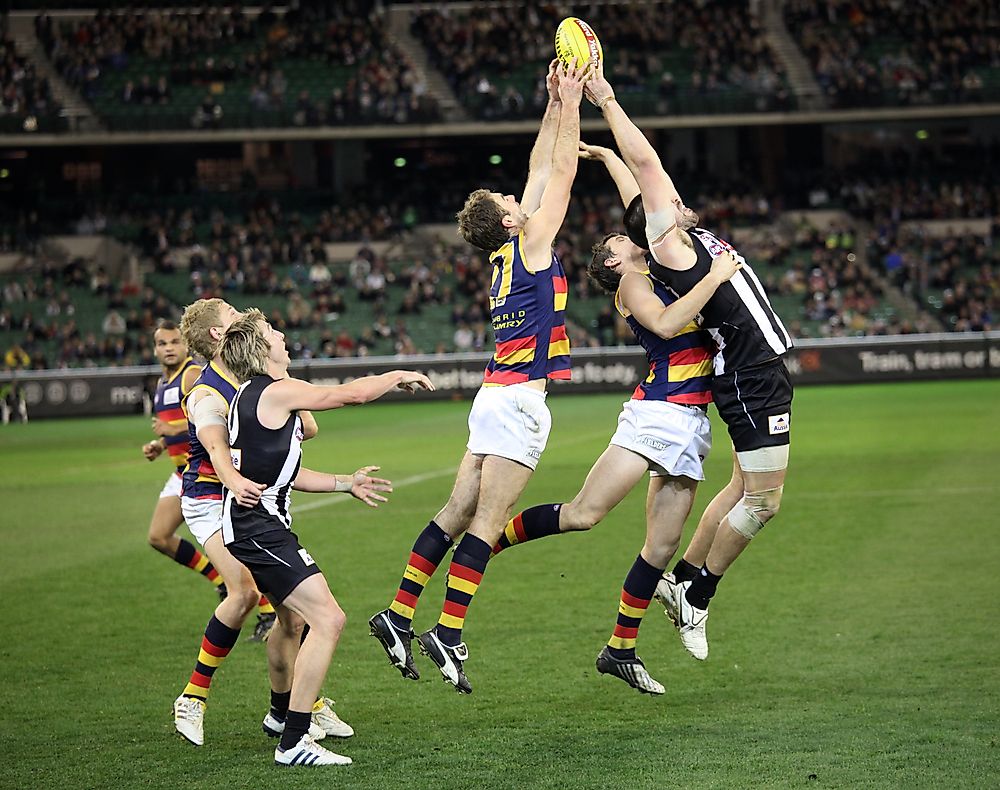What is Australian Rules Football?

Australian football is played on an oval field by 36 players, and it involves physical contact. The football was invented in Melbourne Australia in the late 1850s. The rules of the game were arranged in a systematic order in 1858 when the event became popular. The sport is also known as Aussie Rules or Footy, and Australian Football League governs the sport.
The Ball
The ball used in the sport is made of a bladder with the leather covering the outside part. The balls used have different colors depending on the time the match is held for visibility reasons. It is oval and must meet the following conditions: it has to be between 167mm-173mm in diameter, 270 mm-280 mm in length, a circumference ranging from 720 mm-735 mm, a weight of 450-500 grams, and it must be inflated to 69 kpa pressure.
The Field
The field is sometimes called the ground or the paddock, and it has an oval shape with a length measuring 135 to 185 meters and a diameter of 110 to 115 meters. The goal consists of two pairs of goalposts that are located at the edges of the oval field. The first goalposts are erected 6.4 meters apart along the boundary line with a height of 6 meters, while the second set is situated 6.4 meters from each goal post in the boundary line and has a height of 3 meters. The goal square is drawn 9 meters into the ground from the posts and has a width of 6.4 meters. A line is drawn 50 meters from each goalpost, and any player can kick a goal from this point and beyond to the opponent's goal.
Players
Two teams of 18 players each with a maximum of 4 substitutes on each side make up the total 36 players of the game. The substitutes sit on designated benches and substitution can be done anytime during the match. The players can move to any part of the ground during the match despite having designated positions like Full Forwards, and the field is free to move Half Forwards, Center Line, Half Backs, and Full Backs.
Playing
The direction of the play is determined by tossing a coin during the start of the match. The match is started by blowing the whistle and throwing the ball in the center circle by a Field Umpire. The ball is then contested by players in the middle square and players are prohibited from crossing to the opponent’s side until the ball has been bounced. There are several conditions which make the game to be restarted which include after ‘a behind score,' after the ball has gone out of the playing field, and when players prevent the opponents from clearly accessing the ball.
Between the start and the end of the match, there are four breaks dividing playing time into four quarters with 20 minutes each. During each quarter, the team changes the side of the field they occupy. The time lost when the ball is kicked outside the playing field is compensated at the end of each quarter by adding some minutes depending on the time lost. This time is known as ‘time on.'
The ball is passed across from one player to another trough handballing, kicking, and running with the ball while touching it on the ground on an interval of about 9 meters. Holding the ball or throwing it is against the rules of the game and it results in the other team being given a free-kick. The umpires maintain the discipline of the players by use of awarding free kicks, penalties, and suspension of players.
If the ball kicked passes through the two larger posts, a goal is scored if nobody touched it after being kicked, and this earns the scoring team 6 points. If it passes through the shorter posts or hits the goalposts, it earns 1 point, and it is referred to as a behind score.
Winning
The team that has most points at the end of the match wins the game. The team goes on a draw if they have equal points at the end of the game. If the teams go on a draw during the finals, extra time is awarded for the teams to break the tie.











